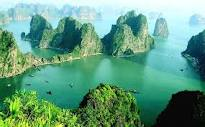Halong bay legend and history

Halong bay legend
The legend of Hạ Long has it that, “Once upon a time, soon after the Việt people established their country, invaders came. The Jade Emperor sent Mother Dragon and her Child Dragons down to earth to help the Việt people fight against their enemy. Right at the time invaders’ boats were rushing to the shore, the dragons landed down on earth. The dragons immediately sent out from their mouths a lot of pearls, which then turned into thousands of stone islands emerging in the sea like great walls challenging the invaders’ boats. The fast boats couldn’t manage to stop and crashed into the islands and into each other and broke into pieces.
After the victory, Mother Dragon and Child Dragons didn’t return Heaven but stayed on earth at the place where the battle had occurred. The location Mother Dragon landed is nowadays Hạ Long Bay and where Child Dragons descended is now Bái Tử Long. The dragons’ tails waving the water created Long Vĩ (present Trà Cổ peninsula) and formed a fine sand beach over ten kilometers long”.
Halong cultural and historical value
The beauty of Hạ Long Bay consists in its mountains, water, clouds, caves and grottoes. Many, however, do not realise that Hạ Long was also the cradle of an ancient people who helped create the present Hạ Long culture.
At the end of 1937, a Swedish archaeologist named Anderson, together with two French archaeologist sisters named Conani, journeyed for months through Hạ Long sea. They climbed mountains, visited caves and explored the coastline, finding many stone artefacts: axes, grinding tables, sewing needles and jewellery. They called the culture that formed these remnants “Ngọc Vừng” In the months and years following, Vietnamese archaeologists continued their research and made many excavations; discovering more archaeological sites, such as Ðồng Mang, Xích Thổ and Soi Nhụ. Through an area of some hundreds of square kilometres, they discovered many stone artefacts and pieces of broken designed pottery.
Throughout its development, Hạ Long has had a particularly important position; being situated on the communication routes between China, Japan and Thailand. Gradually, it became the centre of cultural and commercial exchanges between these countries and ancient Vietnam. The book Comprehensive History of Ðậi Việt reads: "In the second month of the spring of the year of Kỷ Tỵ, the 10th year of the reign of Lý Anh Tông (1149), the commercial port of Vân Ðồn was established.” In the long period overlapping the Lý, Trần and Lê dynasties, Vân Ðồn was a place of busy commercial and cultural exchanges between Vietnam and its South-East Asian neighbours. A remaining vestige of the ancient commercial port is Cái Làng Wharf (Quan Lan).
Vân Ðồn is also a site that witnessed glorious feats of war against the invasion of the Yuan-Mongols aggressors. It was here that the enemy, General Trương Hổ, had an entire fleet of food supply boats set ablaze by Trần Khánh Dư. This contributed greatly to the victory of Bạch Đằng.
Closely linked to this animated commercial centre were many religious architectural constructions; built to meet the requirements of both traders and the population that practised Catholicism and Buddhism.
In particular, in the central zone of the present UNESCO World Heritage Site area, there have been recent discoveries of fascinating archaeological finds: Mê Cung, Thiên Long and Tiên Ông grottoes. The quantity of ancient shellfish in the Melina Spring, indicated by the 1.5 m-thick heaps of shells, amounts to hundreds of cubic metres.
The archaeological sites of the Hạ Long culture are distributed everywhere, but are mostly found on the sandy beaches of the coastline, and in these caves and grottoes: Ngọc Vừng, Tuần Châu, Xích Thô and Ðông Mang. There are also sites far from the coast, such as Thoi Giêng and Tiên Ông. Wherever the remnants of the first peoples of Hạ Long are found, they seem to bear a common characteristic: the same materials, techniques, forms and designs. Scientists have called it the "Hạ Long culture of the late period of the new Stone Age.”
In Cái Làng Wharf, along to 200m-long coastline scientists had found broken pieces of pottery and china forming a 0.6 m-thick layer. Ages date from between the Lý and Trần dynasties. Here, there are also foundations of ancient houses once built along the wharf. Apart from here, many other ancient wharves have been found, such as: Cống Ðông, Công Yên, Ngọc Vừng, Quan Lạn and Cái Bầu. They have featured similar artefacts.
On Cống Ðông Island alone, four pagodas were built. Among them, the Lâm Pagoda is one of the most ancient in the area. It was built under the Trần Dynasty with three gates, a shrine to Buddha, anterior cult room and house of ancestors. On the north-east side of the pagoda was a tower, the remnants of which indicate it was a large and solemn construction.














